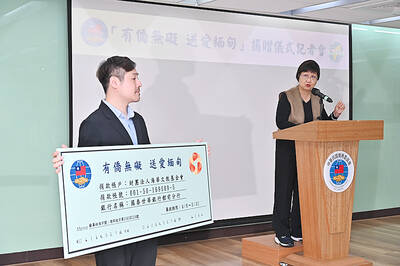Thanks to the Control Yuan's efforts, the 200-year-old Lin Family Gardens will have the chance to be reborn after being almost completely destroyed in the 921 earthquake, academics said yesterday.
A new book by Liu Yung-yi (

PHOTO: SEAN CHAO, TAIPEI TIMES
The book is based on an investigation by the Control Yuan, and tells the story of the legendary Lin family, how their old homestead in Taichung County was damaged by the quake, how the government abandoned the compound and even tried to delist it as a historical site.
The Lin family compound was built in 1858 and consists of 10 areas, including the main compound, pavilions, towers, cottages and gardens. The compound takes up more than 11,000m2.
"The Lin family compound is the encyclopedia of Taiwanese traditional architecture," said Lee Chien-lang (
"It is also the largest compound owned by one clan in Taiwan. It has no counterparts," Lee said.
The Lin Family Gardens were designated a national historical site in 1985. The buildings and gardens were reduced to rubble by an earthquake on Sept. 21, 1999.
According to the book, reconstruction of the compound and gardens were repeatedly delayed, losing both direction and momentum as the project became ensnared in bureaucratic red tape.
Last year, the Ministry of the Interior decided to remove a large part of the compound from the list of historical sites.
Huang Huang-hsiung (黃煌雄) and Ma Yi-kung (馬以工), two members of the government watchdog agency, the Control Yuan, began an investigation into the fate of the compound after receiving a petition from a Lin descendant last year.
"The ministry's policy on the [compound's] reconstruction was shaky and distrusted by people concerned," Huang said.
"When we warned them the first time, they reacted passively and there were even kickbacks from the ministry," he said.
The Control Yuan's efforts to push the ministry have finally paid off. The ministry has allocated a NT$650 million budget to overhaul the buildings and other structures; it also formed an ad hoc committee to supervise and accelerate the reconstruction process.
"We want to thank the Control Yuan, Mr. Huang and Ms. Ma," said Hsia Chu-joe (
As a large family once prominent in Taiwan's history, the Lin family's legends are as attractive as the compound they built, Liu said.
"Take Lin Wen-cha (林文察) for example. A thug in his youth, he later became the governor of Fujian Province's army and navy for the Qing Dynasty. Then he was burned to death after being captured by the troops of the Taiping Rebellion. Wasn't his life dramatic?" Liu said.
If the Lin family story was turned into a TV drama, "it would draw the best ratings," Liu said.
"I once told Ministry of Interior officials that China was trying to adapt the Lin family history for a TV drama series," Huang said.
"If such a story was broadcast one day in China and the family's compound had totally disappeared in Taiwan? there would be nothing more ironic than that," Huang said.

DEFENSE: The National Security Bureau promised to expand communication and intelligence cooperation with global partners and enhance its strategic analytical skills China has not only increased military exercises and “gray zone” tactics against Taiwan this year, but also continues to recruit military personnel for espionage, the National Security Bureau (NSB) said yesterday in a report to the Legislative Yuan. The bureau submitted the report ahead of NSB Director-General Tsai Ming-yen’s (蔡明彥) appearance before the Foreign and National Defense Committee today. Last year, the Chinese People’s Liberation Army (PLA) conducted “Joint Sword-2024A and B” military exercises targeting Taiwan and carried out 40 combat readiness patrols, the bureau said. In addition, Chinese military aircraft entered Taiwan’s airspace 3,070 times last year, up about

Taiwan is stepping up plans to create self-sufficient supply chains for combat drones and increase foreign orders from the US to counter China’s numerical superiority, a defense official said on Saturday. Commenting on condition of anonymity, the official said the nation’s armed forces are in agreement with US Admiral Samuel Paparo’s assessment that Taiwan’s military must be prepared to turn the nation’s waters into a “hellscape” for the Chinese People’s Liberation Army (PLA). Paparo, the commander of the US Indo-Pacific Command, reiterated the concept during a Congressional hearing in Washington on Wednesday. He first coined the term in a security conference last

A magnitude 4.3 earthquake struck eastern Taiwan's Hualien County at 8:31am today, according to the Central Weather Administration (CWA). The epicenter of the temblor was located in Hualien County, about 70.3 kilometers south southwest of Hualien County Hall, at a depth of 23.2km, according to the administration. There were no immediate reports of damage resulting from the quake. The earthquake's intensity, which gauges the actual effect of a temblor, was highest in Taitung County, where it measured 3 on Taiwan's 7-tier intensity scale. The quake also measured an intensity of 2 in Hualien and Nantou counties, the CWA said.

The Overseas Community Affairs Council (OCAC) yesterday announced a fundraising campaign to support survivors of the magnitude 7.7 earthquake that struck Myanmar on March 28, with two prayer events scheduled in Taipei and Taichung later this week. “While initial rescue operations have concluded [in Myanmar], many survivors are now facing increasingly difficult living conditions,” OCAC Minister Hsu Chia-ching (徐佳青) told a news conference in Taipei. The fundraising campaign, which runs through May 31, is focused on supporting the reconstruction of damaged overseas compatriot schools, assisting students from Myanmar in Taiwan, and providing essential items, such as drinking water, food and medical supplies,